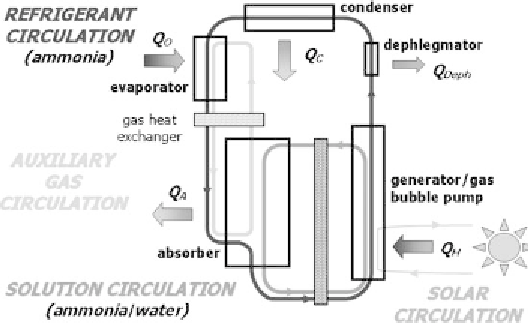Environmental Engineering Reference
In-Depth Information
1979; Bourseau et al, 1987; Gutierrez, 1988; Ajib and Schultheis, 1998). One research
group used the DAHP of the BBT company and modified the DAHP by substituting
the direct gas-fired generator by an indirectly heated one (Braun and Hess, 2002;
St urzebecher et al, 2004). The solar thermal heating capacity of 1.8 kW is provided by
VTCs. The cooling capacity is approximately 1 kW and the COP is 0.59 at a heating
temperature of 175
◦
C and an evaporator temperature of 2
◦
C.
Considering the circumstances that no suitable indirectly driven ACMs with small-
scale cooling performance (1 to 5 kW) are available on the market, the University of
Applied Sciences in Stuttgart has developed a solar-heated SE ammonia/water DACM
with a design cooling capacity of 2.5 kWand heliumas the inert gas (Jakob
et al
., 2003).
A detailed investigation of the performance potential has been carried out as well as
the experimental characterization and optimization of a first prototype and a second
improved one, especially of the newly developed, indirectly heated generator/bubble
pump. A third prototype is currently in the testing phase. Moreover, the performance
of the optimized DACM pilot plant is theoretically analysed and evaluated using a
detailed expanded component model of the DACM process which was developed
based on the characteristic equation of sorption chillers.
Design of the Pilot Plants
An indirectly powered generator/gas bubble pump is used, which has the function of
a solution pump and a thermal compressor. The core components of a DACM are the
generator, condenser, evaporator and absorber as shown in Figure 5.47.
The solution heat exchanger (SHX), the gas heat exchanger (GHX) in the auxiliary
gas circuit and the dephlegmator for the condensation of the evaporated solvent are
vertical tubular, plate or coaxial heat exchangers, which are welded hermetically tight.
Figure 5.47
Configuration of a diffusion-absorption chiller

Search WWH ::

Custom Search